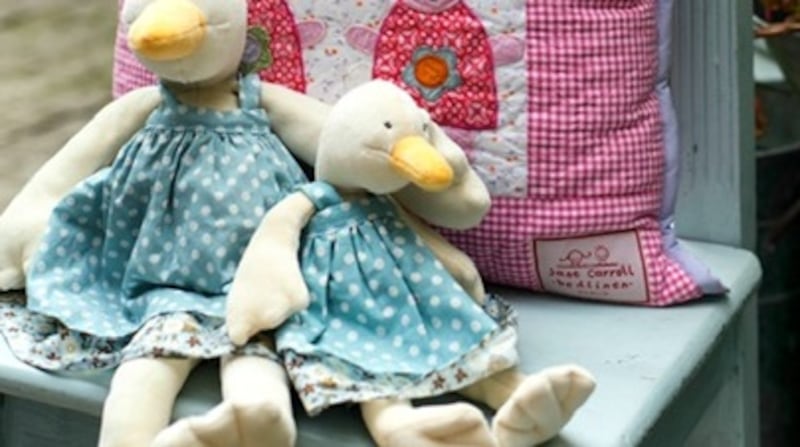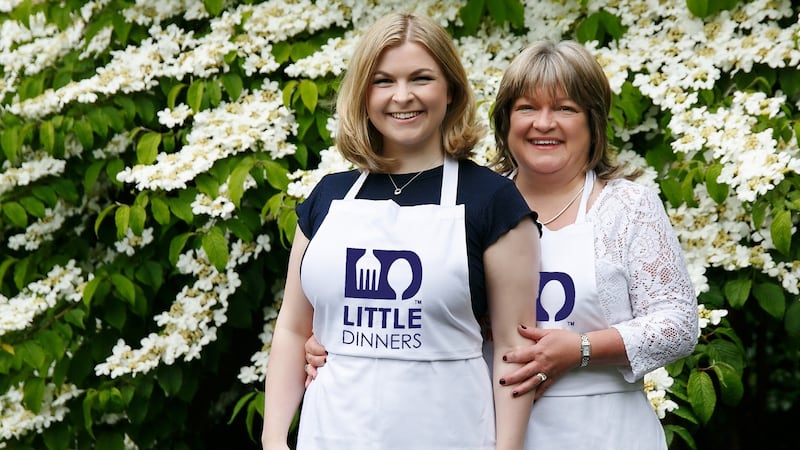Ever thought of going into a business where most of your customers are children? It really can be child’s play, according to successful entrepreneurs whose companies supply cool products and services to the fun-sized kids’ market. A child’s enthusiasm for getting new gear or good food also means a high level of job satisfaction, whether you are selling high-rise bunk beds, tasty little dinners or unique toys and personalised quilt covers.
Jane Carroll is an award-winning textile designer who opened her own wonderland shop in Blackrock, Dublin, and filled it with her eclectic kiddies' clothes, soft toys, beautiful cotton-printed bibs and bunting. In fact, she still is a real child at heart. You can see that irrepressible spirit running through all her fun-filled fabrics that are a blaze of colour and a riot of fairy tale ideas.
“I find that kids love detail, so I stock the Danish range of ‘Maileg’ mice and bunnies with a range of miniature accessories like little pillows, tiny tea sets, teeny kitchens or ballet tutus. Wooden toys are really popular as there is a push against plastic, which easily breaks and has no long-term sentimentality. I also sell fantasy lamps and night lights like giant toadstools, or glowing ducks and owls. They create a soothing space and work well with fairy doors in children’s bedrooms.”
After graduating from the National College of Art and Design with a first-class degree in textile design, Carroll moved to New York, where she worked for Gear, designing children's wallpapers and fabrics; she then moved to the Conran Design group in London, designing ceramics, textiles, rugs and bedlinen.

She eventually returned home and in 2004 opened her first shop in Blackrock, which soon became a key attraction. She launched a fresh range, including her trademark quilts. Orders flew in from Harrod’s, Heal’s and The Conran Shop in London as well as Brown Thomas and Avoca in Dublin.
In 2014, she moved to a larger premises and transformed the shop interior. Local craftsman Brian Kehoe was commissioned to create a unique children's paradise, which resembles a doll's house with Georgian windows and fan-lit doorways and decorated with Carroll's own wallpaper designs and fabrics for a final wave of the wand.
Beautiful bedlinen
Her range of quilts can be personalised with the child’s name and birth date. She also designs quite beautiful bedlinen, as well as a treasure trove of unique gifts handpicked from around the world.
In 2015, the shop was voted into the final of the Irish Times Best Shops in Ireland competition.
[ janecarrolldesign.comOpens in new window ]
Once you have found those quirky quilts and cuddly toys, then you might be pressurised by those persuasive minions in our midst to splash out on a bigger investment like a bouncy bunk bed or a complete suite of bedroom furniture. JellyBean Furniture is dedicated to supplying fab children’s furniture. It was set up by Marie O’Donovan 15 years ago. She now has her own warehouse for online sales as well as a shop in Cork.
“I started off initially with maternity products and then moved into the nursery market. However, I really found my business niche when I moved into the children’s first bed market,” says O’Donovan.
“It’s that exciting time when a child wants the magic of their own special room with a feeling of being grown up too.
“The bunk beds are very popular as are the high sleepers that feature desks and drawers underneath. They act as super space-savers, especially for smaller rooms, while being full of fun and adventure with ladders, hide-outs or more formal school desks.”
The Trasman Jules High Sleeper and the Fargo range are ideal for that eight-plus age group – when kids love to have sleepovers with their pals and create their own fun space. "We sell a lot of beds with pull-out trundles or roll-out futons too."
She is embarking on a new business venture called Pod Furniture.ie with her husband Conor Twomey. "It will be a new departure and once again the online feature will be a major strong sales generator as we will have virtual videos to show how the furniture will look in different rooms."
According to O’Donovan, most people spend about €300 on a first bed for their child, often choosing a simple solid single like the Vipak Amori (€290). “It’s a fabulous bed for the money,” says O’Donovan, who finds beds that retail for less than €200 tend to wobble or creak.
Traditional bunk bed
Despite the huge range of high-sleepers and mid-sleepers on the market, the best seller at JellyBean is still the traditional bunk bed. “Irish people adore their bunks. They’re a very practical option and great for saving on floor space if you have a few kids.”
[ jellybeangroup.comOpens in new window ]

According to Susan McQuaid of Little Dinners, much of a child’s tricky eating phase can be avoided if they are introduced to simple, healthy and nutritious foods at an early stage in life. She has found that once a child gets used to seeing their friends and playmates all eating the same food they want to join in and be part of the experience.
McQuaid and her husband Bernard began their business catering for parties, Communions and special occasions. In spring 2000, just as regulations on food preparation were changing and becoming more stringent, they decided to grow their business and invest in a specially dedicated premises to manufacture a range of kid-centred meals for nurseries, creches and after-school clubs that would become Little Dinners.
“We researched the market and decided to move our business into Rathdrum in Co Wicklow,” says McQuaid. “All our staff are local. We devised monthly menus which are split into three categories for dealing with different age groups. Initially, we provided meals for the creche and Montessori market and then expanded into after-school clubs.”
Up until the lockdown, they were feeding 8,000 to 10,000 children every day.
“The kids love seeing the food vans arriving to the schools,” she says. “You can hear them shout: ‘Here comes the Dinner Man’”
‘Education for life’
Rachel McQuaid studied Marketing and Advertising at DIT before joining the family business and is currently completing an MSc in Business Management. “I believe if you can educate a child from an early age to sample and try out different foods, it’s an education for life. We are creating a healthier generation of children who are more aware of nutrition from an early stage. We feel that it is important to explore the link between physical and mental health and how additives and preservatives affect children’s moods and anxiety levels,” she says.
[ littledinners.ieOpens in new window ]
Orla Walsh is a Dublin artist who almost literally puts the fizz into pop art. Her iconic pop pictures brighten up kids' bedrooms as well as living rooms and corporate HQs all over the world. Her vivid images include a range of popular products from Coca Cola cans in alarm bell red, to Heinz Ketchup, Tayto crisps and Cadbury's crème eggs.
They add a special splash of colour to a playroom or a kids’ den. Last month, she produced a limited-edition Barry’s teabag print with 50 per cent of all proceeds going to Spinal Injuries Ireland.
[ orlawalsh.comOpens in new window ]
Beware GDPR
Companies aiming at the children's market have to pay particular attention to the General Data Protection Regulation (GDPR), according to Natasha Singh, principal consultant, privacy and data protection with Gemserv.
“If your organisation is using children’s or their parents’ personal data, then it triggers the application of the GDPR,” she says. “Children merit specific protection with regard to their personal data, as they may be less aware of the risks, consequences and safeguards concerned and their rights in relation to the processing of personal data.”
The GDPR is more prescriptive about the offer of online services to children, Singh points out. “Where organisations are offering online services or information society services directly to children and relying on consent as the lawful ground in the context of providing those services, the consent of a parent or someone with parental responsibility is needed for children who are under the age of 16.”
The GDPR allows member states of the EU to adjust that limit to anywhere between the age of 13 and 16. The UK has adopted 13 and Ireland has adopted 16 as the age below which consent from a parent or someone with parental responsibility is needed in relation to online services where consent is being relied upon. Organisations must also make “reasonable efforts” to verify that the person providing that consent does have parental responsibilities by making use of available technology.
Singh has some advice to help business owners avoid falling foul of the legislation.
“As per the privacy by design principle, you must build in privacy from the outset and design your processes to protect their data,” she says. “One useful way of implementing privacy by design is by carrying out a data protection impact assessment [DPIA] and implementing measures to mitigate risks. An organisation must carry out a DPIA before beginning any type of processing that is likely to result in a high risk to the rights and freedoms of individuals. Profiling children, targeting children for marketing and online services are activities which are likely to trigger high risks.”
Businesses must carefully choose a lawful ground for processing a child’s personal data, she advises. “Different considerations apply in the context of children’s personal data. Consent is one possible lawful basis for processing, but it is not the only option. Sometimes, using an alternative basis can be more appropriate and can provide better protection for children. You must document your justifications for choosing a specific lawful basis.”
Examples where consent will be needed include when sending marketing emails or texts, or dropping cookies, although the practicalities of obtaining consent from a parent or someone with parental responsibility in these contexts are likely to be extremely challenging.
“Reaching the threshold for consent under the GDPR can be particularly difficult,” she notes. “Especially if a child does not fully understand the implications of their personal data being processed, it will be difficult to demonstrate that their consent is informed and freely given. Similarly, there will often be a clear imbalance of power between a child and a controller where, in effect, a child may feel that consent is not really optional and, in such cases, consent cannot be freely given. Where you rely on legitimate interests, you need to give extra weight to children’s interests and need a more compelling interest to justify any impact on a child’s rights and freedoms. If you are not sure whether you are fully compliant with GDPR, you should seek specialist advice.”












